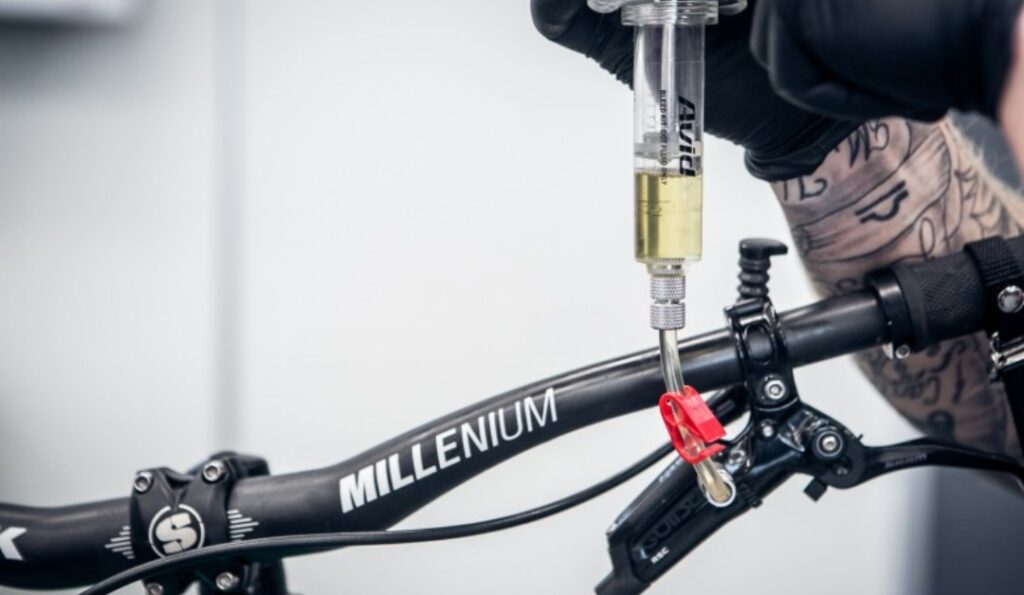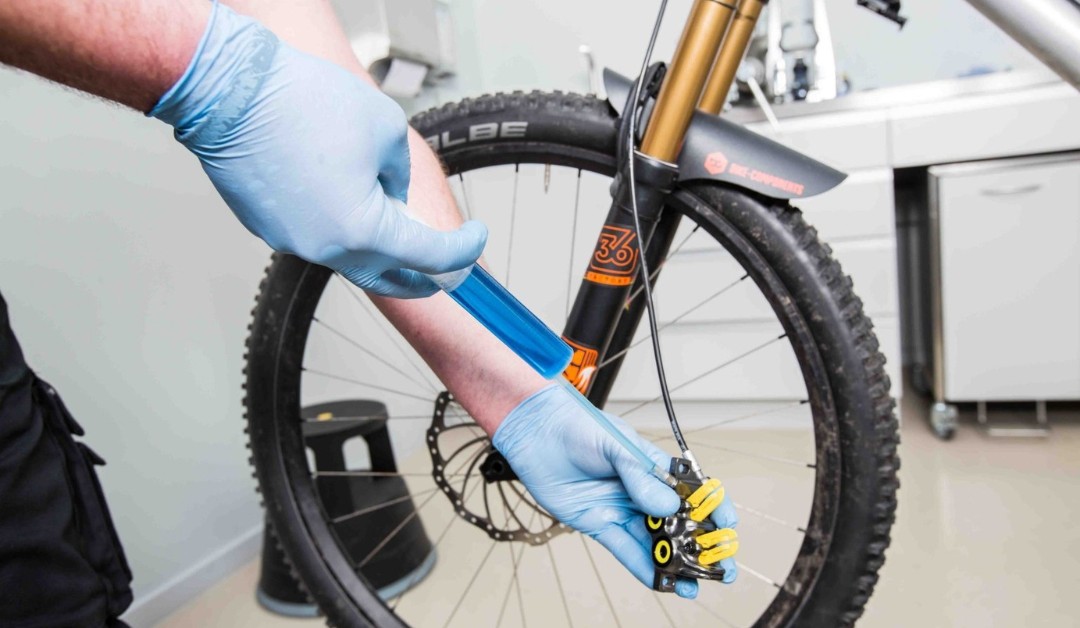How to Bleed Mountain Bike Brakes?
Are your mountain bike brakes feeling inconsistent? Are they feeling a bit spongy? Are they pulling to the bar?
Maybe it’s time to give your brakes a bleed. We’re going to discuss how to bleed mountain bike brakes step by step.
Hydraulic mountain bike brakes use the power of fluid dynamics. We’re not going to go into it too deeply, but essentially, what happens is that fluids aren’t compressible. So if you force up the bike’s lever, it means that the fluid is pushed all the way through the hose and then pushes those pads.
Unfortunately, if you’ve got any bit of air, as you might have in a suspension system, you’ll know that it’s springy in your brake. That’s why you should bleed it and get rid of all the air.
Contents
What Tools Do You Need to Bleed Mountain Bike Brakes?
Before starting, it’s a brief warning time for you!
Mineral fluid! A bit like some other brake fluids. It’s not nice stuff. So be very careful with handling it. So, wear gloves, wear protective eyewear, make sure you keep it off paint and specially off braking surfaces. The other thing that really should be remembered is how you dispose of the oil.
It’s better to use an old container that you can use to pour in the container and then take it to your local recycling centre. So make sure you adhere to your local rules and regulations about disposing of.
Anyway, to do this bleed you’re going to need a variety of different tools. You’ll need a four M to likely adjust your lever. You may need a range of Allen Keys, Torx Keys or a flathead screwdriver to remove the pin that holds your pads in. Obviously the big thing that you’ll need is a dedicated bleed kit. The bleed kit comes with a little kind of storage container, a bit like a yogurt pot that sits on top of the lever and comes with a syringe. It’s got dedicated fitting so you’ll probably need to get the right one for your system so you should do some research.
The other thing that will come with not really a pad spacer but more a piston spacer. Once you’ve removed the pads will hold the pistons in the right place. So you’re not going to walk those out of the calliper. Another thing that you’ll need is surprising. It doesn’t come with a kit but comes with mineral oil.
There’s a number of different aftermarket brands that you can get for your mountain bike as well. But make sure that it’s designed to work with mountain bikes. There’s a couple of different versions out there that might not work with mountain bikes as you think. You’ll need a pad spacing tool to push the pistons back in and push the pads in. You’ll also need some disc brakes.
Bleeding a Mountain Bike Brake

This process, like many fixes on mountain bikes, is much easier with a bike in stand. It’s not essential, but it will make it a lot easier. So try to put the bike on a stand first. In bleeding, the front brake is to be removed from the front wheel and then slowly pushed back in by using a pad spreader. With the pads pushing the pistons all the way back, it’s now time to remove the pads so they don’t get contaminated.
Just be mindful that there’s often a little retaining clip on the opposite side from where the nut is on the calliper. And sometimes these can ping off really quickly. So just be mindful that you keep a hold of it with the pads out. Now, install a piston spacer like a block of plastic that stops the piston from pushing in when you’re moving the fluid around. Remember to use the right one.
Make sure that when you put the piston spacer in, even though it’s a tight fit, you put the retaining pin in to hold it in place. With the pads out and the calliper set up, it is ready to bleed. Now, it’s time to get messy fluids out. But the fluid is brake fluid, so that means you have to get gloves and protective eyewear on.
So as we’ve discussed, we’re trying to get rid of any air in the system and we’re going to help gravity do its magic. Position the lever up sort of making the top of the lever at the highest point. Another advantage of using it at the stand if you’re having to bleed a rear brake for example. The hose routing is a little sort of curvy and undulating, make sure that you tip the bike really high at the front. So the lever is at the highest point. Any air in the system is going to migrate that way naturally through gravity.
Use the mono brakes; they recommend that you adjust the lever, reach out, and if you’ve got a freest stroke adjuster, open up as well. It helps with a bleed process with the lever positioned kind of on the bar in the right place and the lever positioned out from the bar.
Now, take off the top bleed port. There should be a little rubber bung on it. Install the open sort of bucket. Just be careful that you get the threads in correctly. And also be careful not to tighten it too tight. If you’ve got a little plug plunger, make sure it’s fully inserted. Fill it with fluid with a syringe ⅔ full.
Next step is attaching the syringe on the bottom. Remove a little rubber guard with a 7 mil wrench. Once the syringe is on and you need to prep the syringe well. Once you’ve opened the valve, you can release the plug at the top of the reservoir. Just pop it up. You’ve got a little clip space where you can clip that little plugin later.
Begin pressurizing the syringe now. It should flow smoothly through the system. If you get any kind of resistance, it might mean that you’ve got some other issues. So just gently tap the hose, which might accelerate the air movement. If you try to force the syringe, some of the mountain brakes have a relatively delicate diaphragm assembly that can break too much force.
Keep checking that the fluid is flowing from the syringe through and up into the reservoir part. Hopefully, you will see some bubbles come through and even see a colour change. If the fluid is flowing up and it’s still coming through quite darkly, close off the syringe at the bottom and remove it. Fill it up with more fresh mineral oil, reattach the hose, open it up again, and then force it through again.
Make sure that you’re cycling through all that new fluid. Once you’re sure that there are no more bubbles, you’ve pushed the syringe a couple of times, and the fluid flows up really easily. The fluid should look fresh and bright pink with some mountain stuff.
Then lock off the lower bleed port, remove the syringe, and reinstall the rubber grommet. The best practice is then to miss that area with some disc brake cleaner or some isopropyl alcohol to make it clean and remove any of that brake fluid.
Then you can cycle the lever a couple of times and see that it’s all okay. Then take off the upper reservoir or yogurt pot. Make sure that the plug is plugged in because you should remove the OT before pouring mineral oil everywhere. Remove it carefully for safe disposal. Later, return the O-ring and that top plug into the reservoir and screw it nicely and tightly.
Put in your brake pads. Everything is nice and clean now. Carefully put the pads in and check if there’s any issue, because if you’ve done a brake bleed, you may put fresh pads in at the same time. But if the pads are still in good shape, replace them. Then put the wheel back in, and then you can set up your lever. So you can adjust the angle of inclination if you need the lever bite point, and you get the freest stroke adjuster.
Further Reading: What Does a Derailleur Guard Do on a Bike?
Conclusion
Hopefully, the discussion will meet up with all your questions about how to bleed mountain bike brakes. Care for your mountain bike as they need it, and enjoy your climbing journey. You can also change your bike’s brakes to your preferred setting. But before that, you should know how to do it by yourself. At that point, my discussion will help you out!


